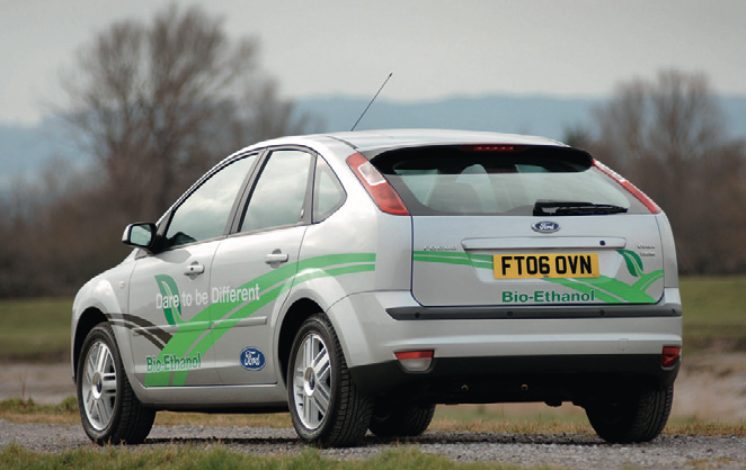Ethanol, a renewable and domestically produced fuel, has been utilized as an alternative fuel source for decades. Ethanol is produced from renewable resources such as corn, sugarcane, and other feedstocks. This biofuel has been blended into gasoline for use in conventional vehicles and has shown promising results in reducing greenhouse gas emissions and reducing dependence on foreign oil. However, the use of ethanol as a fuel dates back much further than its use in gasoline blends. In fact, the first vehicle ever to run solely on ethanol was developed in the late 19th century.
In 1896, a German engineer named Dr. Ferdinand Porsche (yes, the same Porsche that would later become famous for its sports cars) developed a vehicle powered entirely by ethanol. The car, known as the Lohner-Porsche, was an electric vehicle that utilized an onboard generator to produce electricity for the electric motor. The generator was powered by a single-cylinder ethanol engine that could produce up to 3 horsepower.
The Lohner-Porsche was revolutionary for its time, as it was the first vehicle to run entirely on ethanol. At the time, gasoline was the primary fuel source for internal combustion engines, and the use of ethanol was virtually unheard of. However, Porsche recognized the potential of ethanol as a fuel source, and his invention would pave the way for future developments in ethanol-fueled vehicles.
Ethanol continued to be used as a fuel source throughout the early 20th century, particularly during World War II when gasoline shortages were common. However, the widespread use of gasoline and the discovery of vast oil reserves in the United States led to a decline in ethanol usage.

In the 1970s, concerns over oil shortages and environmental issues brought ethanol back into the spotlight. The United States government began promoting the use of ethanol as a fuel source, and in 1979, the first ethanol-powered car was introduced in the United States. The Ford Motor Company developed a prototype vehicle, known as the Ford Taurus E85, which was capable of running on a blend of 85% ethanol and 15% gasoline.
Since then, ethanol has continued to gain popularity as a fuel source, particularly in Brazil where sugarcane-based ethanol is widely used. Ethanol is also commonly used as a fuel additive, with many gasoline blends containing up to 10% ethanol.
In conclusion, the first vehicle to run solely on ethanol was developed in 1896 by Dr. Ferdinand Porsche. This invention was revolutionary for its time and paved the way for future developments in ethanol-fueled vehicles. Today, ethanol is widely used as a fuel source and has shown promising results in reducing greenhouse gas emissions and reducing dependence on foreign oil.
Certainly! Ethanol is a type of alcohol that can be produced from a variety of feedstocks, including corn, sugarcane, and other crops. It can also be produced from waste materials, such as agricultural residues and municipal solid waste.
Ethanol has several advantages as a fuel source. For one, it is a renewable resource that can be produced domestically, which reduces dependence on foreign oil. Additionally, ethanol has a higher octane rating than gasoline, which means it can provide more power per unit of fuel. Ethanol also burns more cleanly than gasoline, which can reduce emissions of harmful pollutants.
One of the biggest challenges facing the widespread use of ethanol as a fuel source is the lack of infrastructure to support it. Most gasoline-powered vehicles in the United States are not capable of running on high blends of ethanol, such as E85 (85% ethanol and 15% gasoline). Additionally, there are relatively few ethanol fueling stations in the US, which can make it difficult for consumers to find fuel for their vehicles.
Despite these challenges, the use of ethanol as a fuel source has continued to grow in recent years. According to the US Energy Information Administration, ethanol production in the US reached a record high of 16.1 billion gallons in 2020. Additionally, the Renewable Fuel Standard (RFS), a federal program that requires a certain amount of renewable fuel to be blended into the nation’s transportation fuel supply, has helped to promote the use of ethanol and other biofuels.
In conclusion, ethanol is a renewable and domestically produced fuel that has been used as a fuel source for over a century. It offers several advantages over gasoline, including a higher octane rating and cleaner burning. While the use of ethanol as a fuel source has faced some challenges, it continues to be an important component of the nation’s transportation fuel supply.
Advantages of Ethanol as a Fuel:
- Renewable: Ethanol is a renewable fuel made from agricultural crops such as corn, sugarcane, and other feedstocks. These crops can be grown and harvested on a regular basis, making ethanol a sustainable and renewable fuel source.
- Domestic Production: Since ethanol is produced from crops grown in the United States, it reduces dependence on foreign oil imports, making it an attractive alternative to gasoline.
- Lower Emissions: Ethanol burns more cleanly than gasoline, which can help reduce emissions of harmful pollutants such as carbon monoxide, particulate matter, and nitrogen oxides.
- Higher Octane: Ethanol has a higher octane rating than gasoline, which means it can provide more power per unit of fuel. This can lead to improved engine performance and increased efficiency.
- Economic Benefits: Ethanol production creates jobs in rural communities and can provide economic benefits for farmers who grow the feedstocks used to produce the fuel.
Disadvantages of Ethanol as a Fuel:
- Reduced Fuel Efficiency: Ethanol has a lower energy density than gasoline, which means that it can reduce fuel efficiency when blended with gasoline.
- Limited Availability: Ethanol is not as widely available as gasoline, and the infrastructure to support its distribution and sale is limited.
- Feedstock Concerns: Ethanol production can compete with food production for crops such as corn, which can drive up food prices and lead to concerns about food security.
- Land Use Concerns: The production of ethanol requires large amounts of land, which can lead to deforestation and other land use issues.
- Water Usage: Ethanol production can be water-intensive, which can lead to concerns about the impact on water resources and the environment.
In conclusion, ethanol has several advantages as a fuel source, including its renewability, domestic production, lower emissions, higher octane rating, and economic benefits. However, it also has several disadvantages, including reduced fuel efficiency, limited availability, feedstock concerns, land use concerns, and water usage issues.









